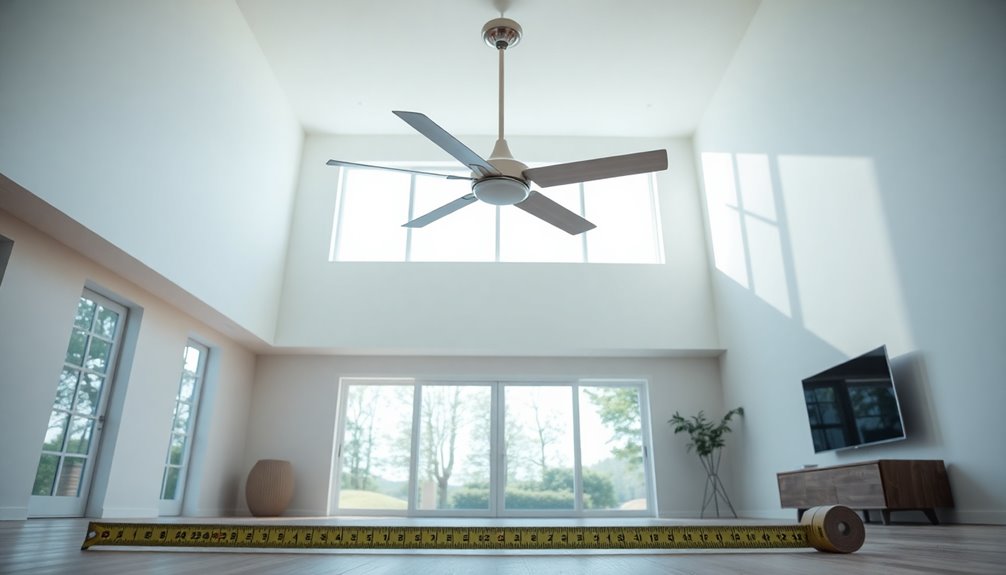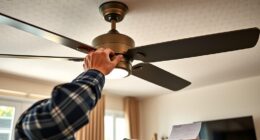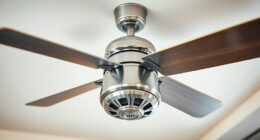To determine the right size ceiling fan, first measure your room's square footage. For small rooms (up to 100 sq ft), look for fans with a diameter of 29-36 inches. Medium rooms (100-225 sq ft) need fans with a blade span of 44-50 inches, while large areas (225-400 sq ft) require sizes of 50-60 inches. For great rooms over 400 sq ft, opt for fans with a sweep of 60-72 inches. Don't forget to take into account your ceiling height and any obstructions that might affect airflow. There's more to think about, so stick around for additional tips!
Key Takeaways
- Measure your room size in square footage to determine the appropriate fan size needed for optimal airflow.
- For rooms up to 100 sq ft, choose a fan with a diameter of 29-36 inches.
- Select a fan with a blade span of 44-50 inches for medium rooms (100-225 sq ft).
- Large rooms (225-400 sq ft) require fans sized 50-60 inches, while great rooms over 400 sq ft need 60-72 inches.
- Consider Energy Star certified fans for energy efficiency and reduced utility bills.
Measuring Room Size
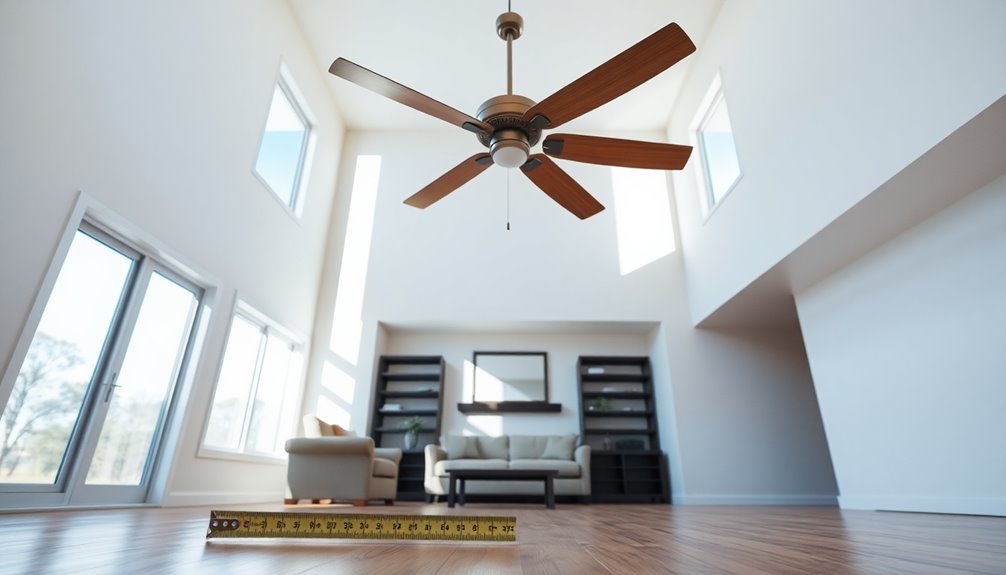
When measuring your room size, start by determining the length and width. To measure the length, use a tape measure from one wall to the opposite wall. Next, measure the width in the same manner.
Once you have both measurements, calculate the square footage by multiplying the length by the width. For example, if your room measures 12 feet by 15 feet, the total square footage is 180 square feet.
If you have an L-shaped room, break it down into two rectangles. Measure the length and width of each section, calculate their square footages, and then sum those results for the total square footage.
Accurate room size measurement is essential because it directly impacts the appropriate ceiling fan size you'll need for ideal air circulation.
Always keep in mind any obstructions, like furniture or architectural features, that may affect the usable area when measuring for fan sizing. These factors can greatly influence your decisions, guaranteeing you choose a ceiling fan that fits your space perfectly.
Ceiling Fan Size Recommendations
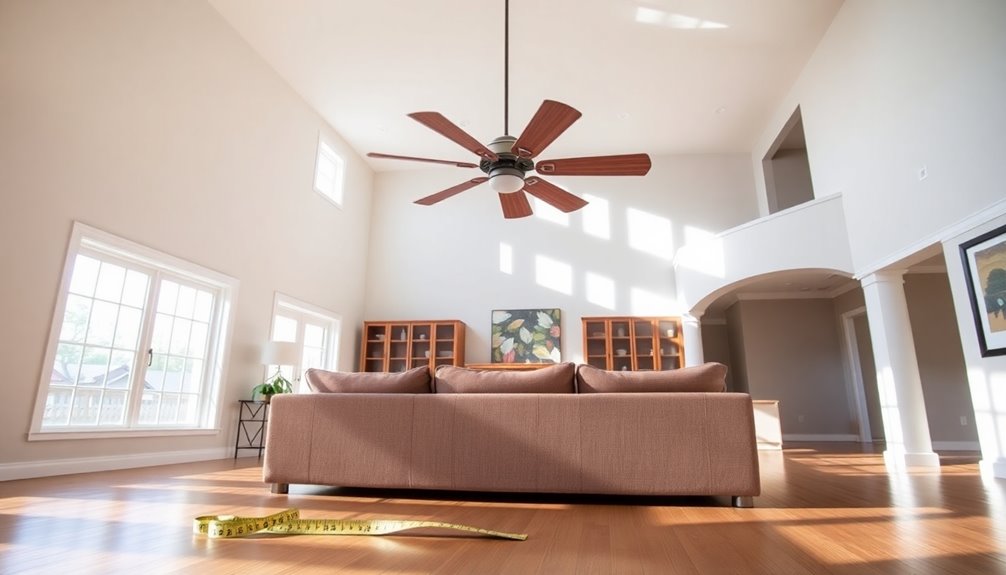
Now that you've measured your room size, it's time to choose the right ceiling fan.
Selecting the appropriate fan size is essential for guaranteeing efficient cooling and comfort in your space. Here's a quick guide to help you decide:
- Small rooms (up to 100 sq ft): Aim for a ceiling fan diameter of 29-36 inches.
- Medium-sized rooms (100-225 sq ft): Choose a fan with a blade span of 44-50 inches. This ensures optimal airflow while maintaining a comfortable environment.
- Large rooms (225-400 sq ft): Go for fans measuring 50-60 inches for ideal airflow.
- Great rooms or open areas (over 400 sq ft): Look for fans with a sweep of 60-72 inches.
- Accurate room measurements guarantee you pick the right ceiling fan size for your needs. Additionally, selecting a fan that is Energy Star certified can lead to lower energy bills while enhancing comfort in your home.
Determining Mounting Height

The height at which you mount your ceiling fan plays a significant role in both safety and performance. To guarantee ideal air circulation and clearance, follow these guidelines based on your room's ceiling height.
| Ceiling Height | Recommended Fan Type | Ideal Fan Height |
|---|---|---|
| 8 – 9 feet | Low-profile ceiling fan | 7 – 9 feet above floor |
| 9 – 10 feet | Standard fan with downrod | 8 – 9 feet above floor |
| Above 10 feet | Downrod installation needed | 8 – 9 feet above floor |
If your ceiling height's between 8 to 9 feet, installing a low-profile ceiling fan keeps the fan height safe while maximizing headroom. For ceilings higher than 9 feet, you'll need to measure the height of the fan housing and select a downrod to achieve the desired hanging height. It's essential to maintain at least 30 inches of clearance from the fan blades to walls or obstructions to enhance airflow efficiency. By following these guidelines, you can guarantee your fan operates effectively while keeping the space safe and comfortable.
Calculating Downrod Length

Calculating the downrod length for your ceiling fan is essential for guaranteeing ideal airflow and safety. To achieve this, start by measuring your ceiling height. Subtract the height of the fan (including the motor and any light fixture) from this measurement. This will give you the required downrod length for proper installation.
Remember to aim for the following:
- Fan blades should be at least 8 inches from the ceiling.
- The fan blades must maintain a minimum height of 7 feet above the floor.
- Guarantee a clearance of at least 30 inches from the nearest wall or obstacle.
- Account for any furniture or cabinets that might obstruct airflow.
- Select a downrod length that accommodates ceilings higher than 9 feet.
Additional Considerations

When installing your ceiling fan, there are a few additional factors to keep in mind to ascertain peak performance.
First, consider light kits that can add height to your fan, which may affect your mounting options and airflow efficiency. Always check the ceiling structure to verify it can support the fan's weight; larger fans might require robust mounting solutions.
If your ceiling is sloped, opt for slope mount fans or angled ceiling adapters to maintain proper installation and airflow. Checking for obstructions such as beams, lights, or furniture is essential, as they can hinder airflow efficiency and overall performance.
Make certain to thoroughly review the installation guidelines provided by the manufacturer. These guidelines will help you understand compatibility with your specific ceiling height and layout, assuring ideal performance.
Utilizing a ceiling fan size guide can also assist you in selecting the right fan and mounting options for your space. By considering these factors, you'll not only enhance your fan's functionality but also create a more comfortable environment in your home.
Frequently Asked Questions
Is a 52 Inch Fan Too Big for a 12X12 Room?
Yes, a 52-inch fan is generally too big for a 12×12 room.
You might find that it creates a wind tunnel effect, making the airflow uncomfortable.
For ideal cooling, a fan with a blade span of 36 to 50 inches is usually recommended for spaces around 144 square feet.
If you still prefer the larger fan for style, just make sure it's installed properly to help manage the airflow effectively.
What Size Room for a 52 Inch Ceiling Fan?
Imagine a gentle breeze wafting through your living space. A 52-inch ceiling fan's ideal for rooms ranging from 225 to 400 square feet.
It'll keep the air circulating, ensuring comfort during warm days. Just make sure it has at least 30 inches of clearance from the walls and that the ceiling height allows for seven feet above the floor.
This way, you get optimal performance without compromising safety. Enjoy that revitalizing airflow!
Is It OK to Oversize Ceiling Fan?
It's generally not a good idea to oversize a ceiling fan.
If you choose a fan that's too large for your space, you might create uncomfortable airflow and uneven temperature distribution. You'll also risk higher energy bills due to excessive power consumption.
Instead, focus on selecting a fan that fits your room's dimensions to guarantee effective cooling and comfort without compromising safety and efficiency.
Always prioritize balance over size for ideal results.
Is a 42-Inch Fan Big Enough for a Bedroom?
A 42-inch fan's often just right for bedrooms between 144 and 225 square feet.
It circulates air effectively without feeling overpowering. If your bedroom's larger than that, you might want to contemplate a bigger fan for better airflow.
Make sure to hang it at least 7 feet above the floor and keep it 30 inches away from walls.
That way, you'll enjoy ideal cooling and comfort in your space.
Conclusion
Choosing the right ceiling fan is like finding the perfect key for a lock; it opens up comfort and style in your space. By measuring your room, considering recommended sizes, and determining the right mounting height, you can create a breeze that flows seamlessly through your home. Don't forget to factor in downrod length and other considerations for peak performance. With the right fan, you'll not only cool down but also elevate your space into a sanctuary of relaxation.
